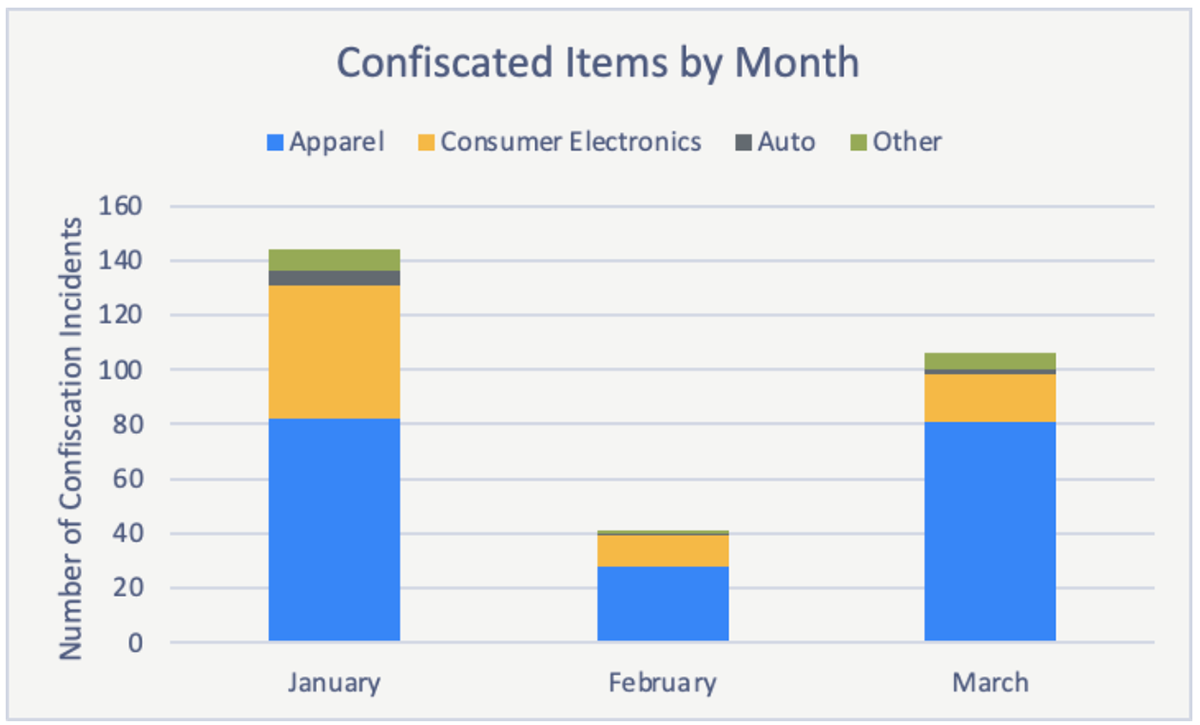We are pleased to launch the first of our quarterly reports on intellectual property infringement based on goods confiscated by the Shenzhen Customs Administration during the first quarter of 2021.
In order to discourage production and sale of illegal facsimiles, the Shenzhen Customs Administration (中华人民共和国深圳海关) regularly announces attempted smuggling of reproductions of branded goods. These announcements include detailed information about the goods seized including aggregate value and brands infringed, as well as identifying information about the company attempting to profit from the goods in question.
Trade in counterfeit goods is a growing problem worldwide. According to the Organization for Economic Co-operation and Development (OECD), counterfeits alone made up 3.3 percent of global trade in 2016. Approximately 55 percent of said counterfeit goods were determined to have originated from the People’s Republic of China (PRC), and about 28 percent originated from Hong Kong.
As a city located on the border of the PRC and Hong Kong, Shenzhen is a key export point for counterfeit goods worldwide. Based on Shenzhen customs announcements, we have compiled a list of entities guilty of counterfeiting globally recognized brands which is available to download upon request. Observations from our study confirm that the Shenzhen microcosm mirrors global counterfeit trends.
About the source
The data for this study was compiled entirely from announcements published by the Shenzhen Customs Administration. The office announces the identities of companies attempting to export goods that violate PRC laws, alongside information about the export goods in question. These announcements are labeled under several kinds of illegal goods, with intellectual property and copyright infringement products falling under their own label. All other forms of smuggling penalties are grouped together under the same label.
Other Chinese city customs authorities make similar periodic announcements. However, most cities’ announcements are sporadic — which could either mean low levels of smuggling occur there or the local agency made a conscious decision to only publicize a few selected cases. Shenzhen customs publicize individual cases nearly every work day, sometimes multiple times a day. Due to the frequency and detailed information contained, we believe the Shenzhen Customs Administration to be a credible source for studying imitation brand goods.
Why Shenzhen?
Shenzhen is uniquely situated to be a hotspot for falsified brands. The city is located on the Northern border of Hong Kong, and many people cross the border regularly for business, to see family, or for leisure. Shenzhen is home to the world’s third largest container port, shipping 27.7 million twenty-foot equivalent units (TEU) in 2018 alone. Next door in Hong Kong is the world’s seventh largest container port, and the world’s most prominent transfer point for counterfeit goods worldwide according to the OECD.

Figure 1. Shenzhen and Hong Kong share a highly populated, porous border, effectively giving regional sellers nearly equal access to both the world’s second and seventh largest shipping ports.Source: United States Central Intelligence Agency- retrieved from the Library of Congress, https://www.loc.gov/item/99443749/.
Shenzhen is a major manufacturing center as well as a tech hub and retail powerhouse. Many major retail brands either have or previously had manufacturing and sales centers in Shenzhen within the past decade.
This combination of shipping networks and manufacturing know-how makes Shenzhen the perfect spot to make facsimiles of famous brands.
Over $2 million worth of fake goods confiscated
In the first quarter of 2021, we counted 135 announcements from the Shenzhen Customs Administration of discovered counterfeit goods, with an estimated cumulative value of $2 million (13.1 million RMB). Many announcements described seizures of multiple falsified brands, which we counted as separate copyright infringement incidents.
Confiscations dropped off sharply in February, which we hypothesize to be a seasonal drop due to the Chinese New Year holiday. In future reports, we intend to look at historical data to verify if this is a regular seasonal fluctuation.

Figure 2. The cumulative value of confiscated goods fell dramatically in February, largely due to a lower number of smuggling instances. The average value of each smuggling instance stayed largely unchanged.
Types of counterfeit goods fell firmly into two primary categories: apparel and consumer electronics. Apparel goods ranged from designer handbags, to branded sportswear. Consumer electronics included smartphones, high-end audio equipment, and electronics components. We also found several instances of auto parts carrying logos from well known international brands.
Our findings match those from the OECD on global counterfeit goods. In their 2019 report, the OECD found that approximately 60% of global counterfeit goods in 2016 were apparel (footwear, clothing, articles of leather, and watches) and about 20% were consumer electronics (electrical machinery, and optical, photographic and medical equipment)

Figure 3. Cumulative confiscations by Shenzhen authorities in Q1 by product type.

Figure 4. Types of goods confiscated by month. Each incident represents one copyright infringement charge. Entities caught smuggling goods infringing on multiple brand copyrights were counted as multiple incidents.
Next steps
For detailed information about the brands infringed on, as well as the companies Shenzhen authorities identified as participating in copyright infringement, please download our accompanying dataset.
Shenzhen Customs Seizure Dataset
Request our accompanying dataset for detailed information about the brands infringed on, as well as the companies Shenzhen authorities identified as participating in copyright infringement.